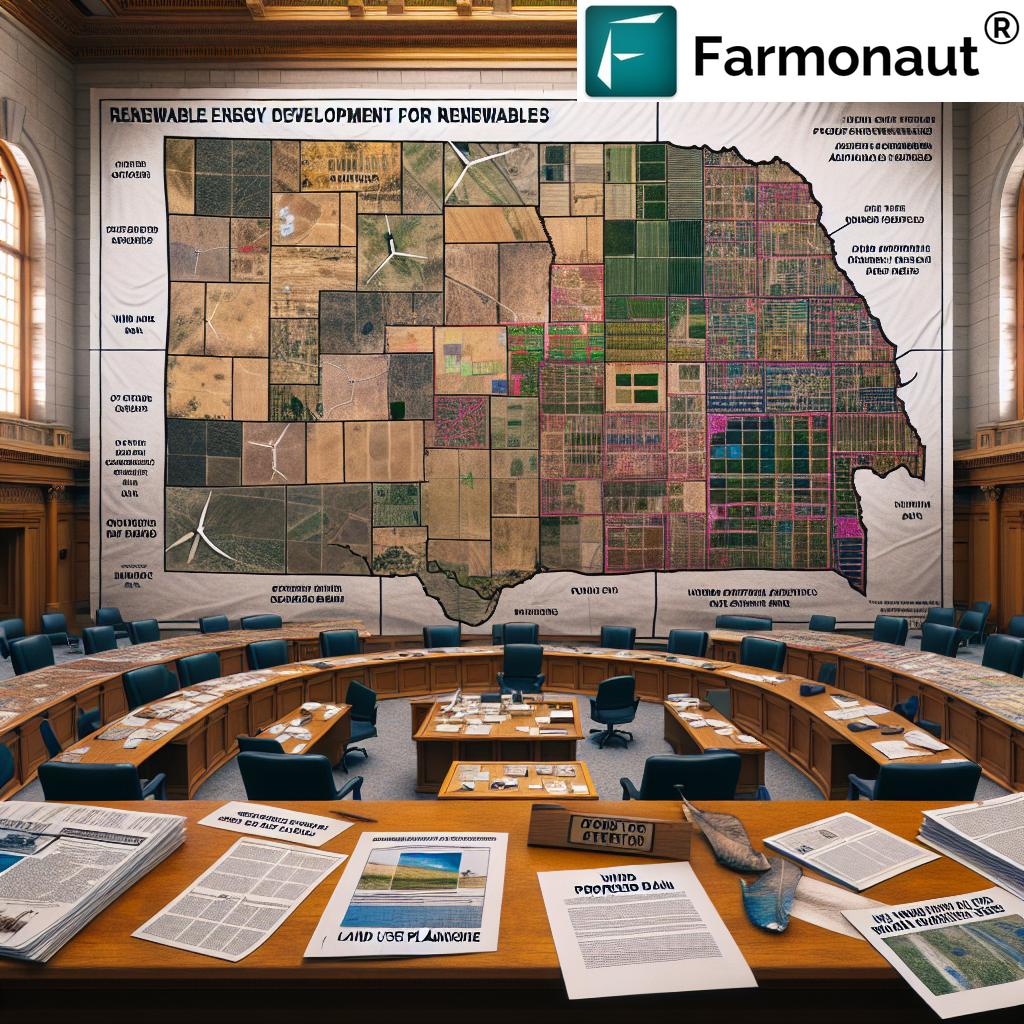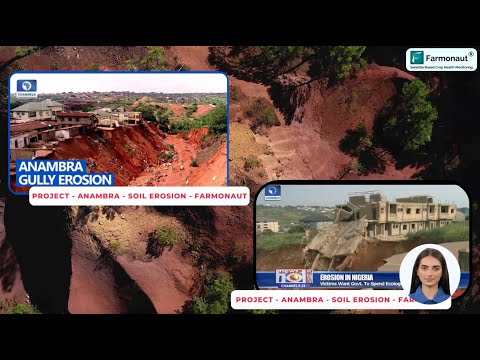Knox County Wind Energy Projects: 5 Key Impacts of the Proposed Ban
Table of Contents
- Introduction: Renewable Energy and Knox County
- Overview of Knox County Wind Energy Projects
- Renewable Energy Zoning Regulations in Knox County
- Public Hearings and the Community Voice
- The Proposed Wind and Solar Project Ban
- Table: Estimated Impacts of the Proposed Wind and Solar Project Ban in Knox County
- 5 Key Impacts of the Proposed Ban
- 1. Land Use Restrictions for Renewables
- 2. Agriculture Revenue and the Local Economy
- 3. Employment and Workforce Impacts
- 4. Tax Revenue and County Finances
- 5. Community Wellbeing and Public Welfare
- Property Rights and Renewable Development under the Law
- Planning for Sustainability: Land Use in the Era of Renewables
- Farmonaut’s Role in Sustainable Land Management
- Farmonaut Subscription Plans
- FAQs: Knox County Wind Energy & Solar Project Ban
- Conclusion: The Path Forward for Knox County
Introduction: Renewable Energy and Knox County
Renewable energy development is shaping the future of community landscapes across the United States, and Knox County wind energy projects have emerged as a focal point in the debate over land use, property rights, and sustainable growth in northeast Nebraska. The current wave of discussions, zoning regulations, and legal hearings point to a pivotal moment for both the agricultural and tourism-focused economy of the region.
With the Knox County Board of Supervisors moving towards a potential ban on new commercial wind and solar projects, we must examine the intersection of policy, landowner interests, public welfare, and economic prospects. Renewable energy zoning regulations, public hearings, and even federal court battles are now central to policy-making and community dialogue in Center, Neb., and the surrounding district.
In this comprehensive analysis, we explore:
- The scope and background of Knox County wind energy and solar projects in Nebraska
- The role and evolution of county zoning and planning commission regulations
- Key impacts of the proposed wind and solar project ban—from land use to local livelihoods
- The balance between property rights, renewable energy development, and community concerns
- Farmonaut’s solutions for sustainable land management in transitionary agricultural contexts
Overview of Knox County Wind Energy Projects
Knox County, located in northeastern Nebraska and anchored by Center, Neb., has historically thrived on agriculture and tourism. In recent years, however, the area has drawn industry-wide attention with proposals for large-scale wind and solar developments.
- North Fork Wind Project: Proposed by NFW LLC (a National Grid Renewables subsidiary), this industrial wind energy development represents a $1.3 billion investment. The project would encompass 42,700 acres and erect over 150 turbines, each exceeding 600 feet in height.
- Bluestem Energy Solutions’ VRDG LLC Solar Project: Planned as a 325 MW commercial solar project about 10 miles west of Verdigre, Neb., crossing into Knox and Holt counties, this initiative would have converted 1,150 acres of pasture and row crop land and required roughly $450 million in capital.
Both projects exemplify the scale and ambition of commercial solar projects in Nebraska and demonstrate the region’s potential as a hub for renewable energy development Nebraska. However, these developments also raise vital questions about land use planning for renewables, future zoning controls, agricultural land conversions, and the preservation of Knox County’s traditional livelihoods.
Renewable Energy Zoning Regulations in Knox County
Renewable energy zoning regulations have become the linchpin of the policy debate in Knox County. County supervisors, the planning commission, and participating landowners are grappling with how to regulate—or potentially ban—industrial-scale wind and solar projects.
Key Regulatory Elements & Recent Amendments
-
Zoning Chapters and Sections:
- Chapter 9 (Community, Utilities and Energy) – covers comprehensive land use and utilities management.
- Section 8.08 – commercial/utility grade wind energy systems zoning regulations.
- Section 8.23.05 – commercial solar conversion systems zoning provisions.
- Setback Requirements: In 2023, the county instituted a 1.25-mile (6,600-foot) setback for industrial wind turbines from nonparticipating dwellings, a significant restriction designed to balance property rights with health, safety, and general welfare concerns.
- Repeal and Ban Proposals: The current proceedings include potential repeal of the aforementioned sections and a move to ban new commercial wind and solar systems, core to the current debate in public hearings.
Public Hearings and the Community Voice
The public hearings on renewable energy projects have brought citizens, landowners, county officials, and energy developers to the same table. The Knox County Planning Commission scheduled two such hearings on May 6 at The Barn at God’s Country, Center, Neb. The purpose? To gather testimony on the potential health, safety, welfare, and property rights impacts of further commercial renewable energy development.
-
Discussion Points:
- The effect of wind and solar project ban on the social fabric and economic viability of rural communities
- Concerns over agriculture, recreational land, and long-term land use
- Testimony from both supporters and opponents, representing varied interests
- Outcome Sought: County supervisors tasked the planning commission with preparing an evidence-based report on the recommendations and overall community sentiment regarding the wind and solar energy regulations.
The Proposed Wind and Solar Project Ban
On April 3, in a 6-1 vote, the Knox County Board of Supervisors took a definitive step by instructing the planning commission to formally consider a ban on all new commercial wind and solar energy projects. This action is not only a policy shift but also the culmination of a year-long build-up of regulatory delays, lawsuits, and competing stakeholder interests.
The rationale provided by Vice Chairman Marty O’Connor resonates with many rural community advocates:
“Both agriculture and tourism would be impaired and changed for decades by such a takeover of land belonging to the people of Knox County and the citizens that visit Knox County.”
- Renewable energy development versus preservation of prime agricultural and recreational land
- Community sovereignty versus corporate infrastructure expansion
- Short-term and long-term effects on local livelihood, culture, and landscape
Table: Estimated Impacts of the Proposed Wind and Solar Project Ban in Knox County
| Impact Area | Current Status (With Projects) | Projected Status (With Ban) | Estimated Quantitative Effect |
|---|---|---|---|
| Land Use | Up to 10,000 acres in transition to wind/solar development | Land remains in traditional agriculture and recreation | Over 10,000 acres retained for agriculture |
| Agricultural Revenue | Supplemented by renewable energy lease payments | Revenue remains solely from farming/tourism | Potential loss of $3.5–5 million/year in lease & royalties |
| Employment Opportunities | Short-term construction and long-term maintenance jobs | Limited to traditional sectors (farming/tourism) | 100–200+ jobs (direct & indirect) not created |
| Tax Revenue | Increased property, sales, and business tax base | Modest growth from existing sectors | Estimated $1–2 million/year in lost tax revenue |
| Community Wellbeing | Diverse economic base, but concerns over health, safety, and views. | Preserved rural character but less economic diversification | Community division may persist; lifestyle preservation for some |
5 Key Impacts of the Proposed Ban
1. Land Use Restrictions for Renewables
The wind and solar project ban would immediately affect over 10,000 acres previously identified for potential renewable energy developments. Throughout Nebraska and Knox County, wind and solar companies select land parcels based on wind speeds, solar irradiance, proximity to transmission lines, and economic viability. Prohibiting commercial projects directly preserves these acres for agricultural cropping and pasture, forestalling landscape changes associated with utility-scale systems.
Yet, this also means a pause in the transition toward a more diversified, lower-carbon land use portfolio—a central aim of modern land use planning for renewables. For farmers and landowners poised to participate in energy lease arrangements, the ban means a return to sole dependence on commodity markets, with fewer opportunities for supplemental land income.
2. Agriculture Revenue and the Local Economy
A primary concern is the effect on local agricultural revenue. Impact of wind energy on agriculture often extends beyond the footprint of turbines or panels; lease payments, shared royalties, and community benefit agreements generate new value streams for rural landowners across Nebraska.
- Farms hosting turbines (or large-scale solar arrays) can receive annual payments, insulated from crop price volatility.
- Commercial solar projects Nebraska-wide offer similar revenue opportunities for landowners close to grid infrastructure.
- The loss of $3.5–5 million per year (in combined lease payments and local royalties) would be significant in a county the size of Knox.
Such revenue can drive equipment upgrades, farm succession planning, and even tourism diversification—especially when coupled with traceability and sustainable branding (see Farmonaut’s Product Traceability solution for documenting sustainable land management and agricultural best practices).
3. Employment and Workforce Impacts
At peak build-out, each commercial project brings direct construction jobs, as well as indirect positions in services, equipment supply, and ongoing operations/maintenance. The ban could mean losing between 100 and 200 direct and indirect job opportunities locally—a major figure in a agricultural county—alongside associated economic multipliers.
Neighborhood retailers and service providers also benefit from construction and maintenance worker patronage. Without project activity, Knox County will have to rely on job creation solely from traditional farming and seasonal tourism, which may not match the diversity or year-round stability these projects could provide.
4. Tax Revenue and County Finances
One of the direct measurable impacts is on tax revenue. Wind and solar projects contribute through property taxes, sales taxes on construction materials, and sometimes even payments-in-lieu-of-taxes. For Knox County, the foregone revenues—estimated between $1 and $2 million annually—may limit funds available for schools, roads, and essential public services.
While the existing agricultural and tourism sectors generate steady but modest returns, commercial renewable energy can be a boon for local infrastructure, educational investments, and rural health services.
Farmonaut’s carbon footprinting tools can also help local governments and agribusinesses track and monetize emission reductions—an increasingly valuable asset in future sustainability-driven food and energy markets.
5. Community Wellbeing and Public Welfare
The debate ultimately centers on community wellbeing—its health, safety, and general welfare. Those in favor of the ban stress concerns about landscape aesthetics, potential infrastructure noise, property value impacts, and a desire to retain Knox County’s rural character. Others believe in embracing energy diversification to ensure a resilient economic future for citizens.
With the county public hearings on renewable energy ensuring all voices are heard, it’s clear that societal impacts are about more than dollars and acres. They also encompass access to opportunity, generational farm security, and the quality of life for both current landowners and future citizens.
Property Rights and Renewable Development under the Law
In 2023 and 2024, conflicts peaked as the North Fork Wind Project (NFW and local landowners) filed a federal court complaint alleging Knox County’s newly-introduced zoning regulations violated property rights guaranteed by the Fifth Amendment’s Takings Clause and Nebraska’s constitution.
- District Court Rulings: Senior U.S. District Judge John Gerrard allowed plaintiffs to pursue claims under the Fifth Amendment—if they could prove a “vested interest” in nonconforming use of their properties for wind development.
- Takings Clause: “Government may not take private property for public use without just compensation”—the legal heart of the complaint and ongoing proceedings.
- Nebraska Law: Adds a corollary clause reinforcing the need for just compensation and legal due process in zoning-related “takings.”
The legal limbo over property rights and renewable development sets important precedents for wind and solar energy regulations statewide, not just in Knox County.
Planning for Sustainability: Land Use in the Era of Renewables
Balancing agricultural productivity, food security, rural culture, and renewable energy infrastructure is a challenge playing out not only in Nebraska but across the nation. County-level zoning regulations and comprehensive plans are fundamental tools in this process.
Lessons from Renewable Energy Development Nebraska
- Inclusion of public hearings on renewable energy in all regulatory changes.
- Clear communication of effects of renewable projects on agriculture and recreational land.
- Data-driven assessment of community, environmental, and financial wellbeing.
- Integration of emerging technologies to monitor and manage land use.
As landowners, county officials, and the public deliberate, evidence-based tools like Farmonaut can help document and plan for responsible, sustainable land transitions whatever the future legal landscape may bring.
Farmonaut’s Role in Sustainable Land Management
At the crossroads of tradition and innovation, Farmonaut helps ensure farmers, county boards, and planners have access to actionable insights for the sustainable future of land management. Our platform leverages cutting-edge technologies to support both individual farmers and large-scale landowners across Nebraska and beyond in understanding and optimizing their land use choices.
-
Satellite-Based Crop Health Monitoring:
- Track field-level changes before, during, and after renewable project development or conversion.
- Monitor NDVI, soil moisture, and crop stress—helpful for both traditional and diversified agriculture.
-
Jeevn AI Advisory System:
- Get field-specific recommendations by integrating weather data, crop models, and zoning restrictions.
-
Blockchain Traceability:
- Prove sustainable management and compliance with zoning regulations for agricultural products.
-
Carbon Footprinting:
- Demonstrate, report, and monetize climate benefits of sustainable farm practice and low-carbon land use choices.
-
Fleet and Resource Management:
- Optimize logistics and operations as land use patterns shift, potentially reducing emissions and operational costs (Farmonaut Fleet Management).
Farmonaut’s offerings can also power satellite-based verification for crop loans and insurance, removing red tape and reducing fraud risks—valuable for both landowners repurposing acres and established family farms.
Farmonaut Subscription Plans
Our subscription-based platform delivers flexibility and affordable precision agriculture to individual farmers, agribusinesses, and institutions worldwide. Choose only what you need—from basic monitoring to advanced advisory systems—accessible via Android, iOS, web apps, and API.
FAQs: Knox County Wind Energy & Solar Project Ban
-
What sparked the proposed wind and solar energy project ban in Knox County?
Concerns over land use, health, safety, agriculture, and the long-term impact of industrial-scale projects prompted the proposal. Public hearings and testimonies led the county board to formally pursue a potential ban. -
How many acres could be affected by the ban?
Over 10,000 acres, previously earmarked for wind and solar project development, may remain in agriculture and recreation if the ban is enacted. -
Will existing individual wind and solar installations be impacted?
No. The current proposal allows for continued individual use per regulations; the ban specifically targets new commercial or utility-grade developments. -
How does the federal court ruling affect the ban?
The judge allowed the plaintiffs (developers and participating landowners) to pursue constitutional claims related to property rights and nonconforming land use. The outcome may set important legal precedents in Nebraska. -
How can Farmonaut assist during such county-wide transitions?
By providing satellite-based monitoring, AI advisories, and environmental impact tracking, Farmonaut equips landowners and local officials with evidence-based tools for sustainable, data-driven decision-making. -
Where can I get more information on renewable energy zoning regulations in Knox County?
Contact the county’s zoning administrator at [email protected] or visit the county’s website at knoxcountyne.gov. -
How will the ban impact agricultural revenue in Knox County?
The ban may reduce potential income from land leases and royalties associated with renewable energy projects, disproportionately impacting landowners who had secured such agreements.
Conclusion: The Path Forward for Knox County
The fate of Knox County wind energy projects is now at a crossroads, emblematic of wider debates on renewable energy zoning, property rights, and sustainable rural development. The outcomes of current public hearings, court challenges, and county board votes will resonate well beyond northeast Nebraska—offering lessons for any district managing competing land use, agricultural, citizen, and environmental priorities.
Farmonaut is committed to empowering stakeholders with accessible technologies, robust data, and AI-driven insights that support sustainable agriculture, effective land use planning, and evidence-based decision-making in a changing world. By aligning local knowledge with modern innovation, we can help secure both prosperity and environmental stewardship—no matter what side of the wind and solar project ban debate we stand.






















